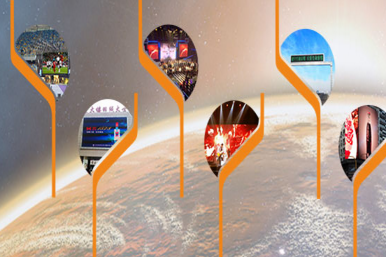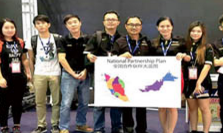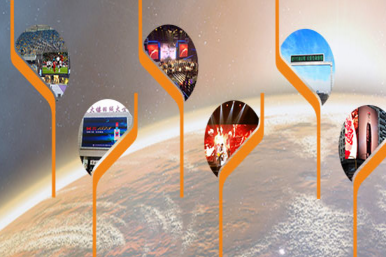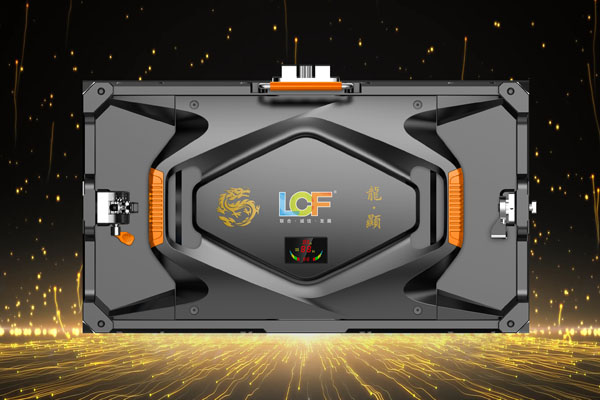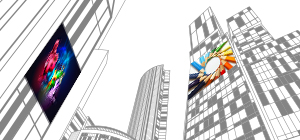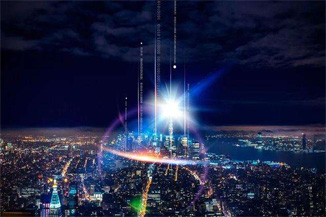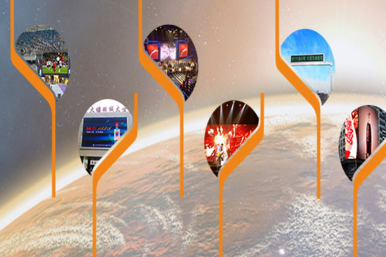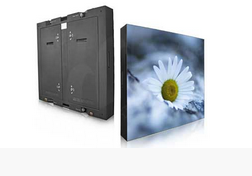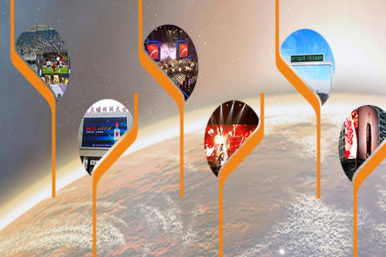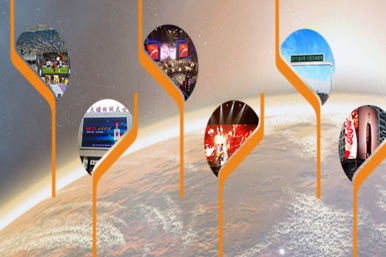Publisher: Supplier of LED Display Time: 2022-03-07 14:22 Views: 1744
The ups and downs of 2021 have passed, and the LED display has ushered in a new journey. In the past year, the industry has encountered an important crisis other than the epidemic - the shortage of cores, and the market situation has been fluctuating with the impact of the epidemic. The overseas market is sluggish, and the domestic display market continues to have new competitors entering the market. The effect of industry leaders gathering is significant, and the industry competition has entered a white-hot stage. Time flies, and in the blink of an eye 2022, a new round of competition has sounded, and industry screen companies are also paying attention to how to win market opportunities under the new year's industry storms.
The competition pattern of the whole industry chain has been established, showing that upgrading has become an inevitable trend
In recent years, the market competition of LED displays has become increasingly fierce. After the baptism of the epidemic, the lack of cores and the price war at the end of last year, the industry agglomeration effect has been further strengthened. As the development of the LED display industry gradually matures, the market competition trend of the LED display market from incremental competition to stock competition has already emerged. At the same time, with the market's pursuit of higher display effects, cutting-edge technology has increasingly become a point of publicity and competition for high-end display products. Now, the competition of leading companies is not only about product quality, market channels and after-sales service, but also the layout of cutting-edge technologies. Last year, mini/micro LED display technology has been a hot topic in the industry. Coupled with the impact of the shortage of cores, there are constantly screen companies deploying the upstream chip industry, including high-process chip products, new light-emitting materials and substrate materials, and packaging technology. Through technological upgrades While increasing the added value of products, expand the influence of screen companies in the industry and enhance their right to speak. Through technological innovation, the application scenarios of the display can also be expanded, allowing the LED display to enter more display fields and further expand the market. As far as the current market situation is concerned, the LED display industry has opened a competition pattern of the whole industry chain from the upstream technology end to the downstream application end.
With the gradual upgrading of industry technology and the increasing market demand for high-end display products, screen companies are increasingly aware of the importance of technology additions to market competition. Enterprises are always striving in two directions for the technological innovation and upgrading of products. One is to meet the increasing display demand of the market for LED displays, including excellent display effects, high stability, high protection and intelligent systems. , the integration of high-tech equipment and so on. Another direction of technological upgrading is to reduce costs and improve production efficiency while maintaining or upgrading the display effect of products in the production process.

The micro-pitch market is expanding, and the replacement of chips, packages, and substrates is in progress
Since the development of the LED display industry has always been moving towards a smaller pitch, how to reduce the cost of the screen enterprises and improve the production efficiency while reducing the pitch has become one of the necessary directions for the technology upgrade of each screen enterprise. At present, there are two main types of small-pitch packaging technologies on the market: SMD four-in-one packaging and COB packaging. COB packaging technology is to adhere the bare chip on the interconnect substrate with conductive or non-conductive glue, and then wire bond to achieve its electrical connection. Since the bare chip is the main body of the chip and the I/O terminals are above the crystal, the bare chip needs to be bonded to the PCB with conductive/thermal adhesive during soldering. Under the action of hot pressing, they are respectively connected to the I/O terminal pads of the chip and the corresponding pads of the PCB. After passing the test, they are sealed with resin glue. The advantage of COB technology is that it can reduce production steps, improve efficiency and reduce costs in the production process. However, COB packaging technology also has shortcomings. First of all, the equipment needs to be updated. The production process needs to be equipped with a welding machine and a packaging machine. The initial investment is high. Zhang modules are scrapped, so how to improve the yield of COB packaging has become the focus of technology upgrades for screen companies. With the continuous maturity of COB technology in recent years, the competitive advantages of COB packaging products are also increasing, and the small-pitch products using SMD four-in-one packaging technology are competing with them. However, the lower limit of the pitch of small-pitch products of SMD four-in-one packaging technology is always limited, and the market will also separate with the maturity of technology and the continuous development of small-pitch products, and the competition between the two will eventually come to an end. The final stage of COB packaging technology is the micro-pitch mini/micro LED market.
With the miniaturization of packaging, the requirements for substrates are getting higher and higher. Traditional PCB substrates cannot meet the requirements of mass transfer technology for substrates in the production process of mini/micro LEDs. Low yield and low production efficiency are the whole industry. A headache for developers. So looking for alternatives has become a major trend in the industry. Due to the high performance requirements of MiniLED backlight for PCB substrates, the products that can meet the requirements at present basically need to be imported from abroad or Taiwan. This has caused the price of PCB substrates to remain high, and this high cost has also extended to Mini backlight products. In addition, the heat dissipation of the PCB substrate is limited, and the micro-pitch products will have more lamp beads welded on per unit area. The high heat generated during the welding process can easily cause the PCB substrate to warp and deform. Glass substrates are superior to PCB boards in terms of flatness and stability, and will undoubtedly become a major trend in the industry in the future. With the advancement of industry technology, the market demand for high-process chips will also increase. At the same time, in order to further reduce costs in all aspects, new luminescent materials have gradually become the focus of the industry.
Technology support promotes the segmentation of application scenarios, and more markets are being developed
In 2021, many market segments will emerge, some of which will be prosperous due to policy impetus, and some will be expanded due to technological development and market conditions. But the boom in those markets isn't going away with 2021. There is still huge room for development in some markets that are driven by policies. 2021 is the first year of the 14th Five-Year Plan. Some projects to promote economic development are being implemented. Next, the industry economy will enter a stage of rapid development with the implementation of policies. The "Ultra HD Video Industry Development Action Plan (2019-2022)" promulgated by the Central Station has not yet ended. The state continues to increase investment in the high-definition display industry, and some provinces and cities are still promulgating relevant regulations. 2022 is the last year of the action plan, and there must be another round of policy support. At the same time, the landing activities of 100 cities and 1000 screens are still in progress. Next year, the ultra-high-definition large-screen display market will have more room for policy dividends.
And some sub-sectors continue to expand with the continuous maturity of technology and market, and it is a huge blue ocean market. In recent years, the new retail market has continued to expand. Although the development speed has been reduced due to the impact of the epidemic in the past two years, with the stabilization of the epidemic and the further improvement of people's consumption level, there is still a lot of room for development. Commercial advertisements are displayed on large screens. And the digital signage market has a good prospect, and some subdivided products, such as the glass curtain wall of retail stores, have been hot in the market in recent years. With the maturity of LED display technology in recent years, the application of large LED display screens in the cinema market will also enter the next stage of competition. In 2021, two leading companies in the industry have obtained DCI certification for movie screens. With technological advancement and cost reduction, the LED movie screen market is a big cake, and Chinese screen companies will also have a place in the future; at the same time, the topic of the metaverse is still hot, and related industries and markets will further mature. The expansion of these new markets will create a more or less demand for large-screen displays, which will also become another new market. Of course, LED display will not become a bystander in the "meta era". In recent years, the integration of LED display technology with cloud intelligence, big data, VR/XR and other technological means has opened up many new application scenarios, including immersion Experience hall, virtual studio, etc. At present, many screen companies are also making technical reserves for the competition in the metaverse market, and 2022 may be the year of science fiction display.
As the spacing decreases, the production technology of small-pitch products gradually matures, and the market scale in the commercial display field continues to expand. The maturity of COB packaging technology enables LED display products to enter more high-end display places. Mini/micro technology is maturing, accelerating the implementation of market applications such as home color TVs, gaming screens, and automotive displays. In the future, new opportunities will continue to emerge in the market with technological upgrades. The rise of the metaverse concept is still slowly building a new market system, and display equipment will surely occupy a place. How to be preconceived about LED displays requires more opportunities in technology and innovative applications.
